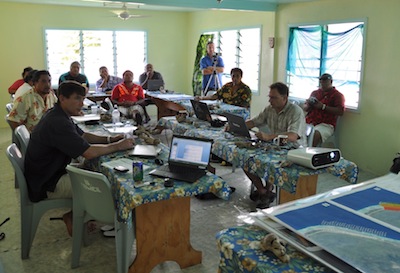
31st August 2012 - A study of tropical cyclones and associated wave action is providing information that can be used to assess the resilience of Mangaia, the most southern of the Cook Islands, to the impacts of climate change and sea level rise.
Mr Jens Kruger of the Secretariat of the Pacific Community (SPC) said that with coastal communities, private property, family homes and public infrastructure, such as the harbour, already exposed to extreme weather events, the recent study will help to support a risk-based approach to climate change adaptation.
Mr Kruger is the Physical Oceanographer with SPC’s Oceans and Islands Programme in the Applied Geoscience and Technology (SOPAC) Division.
He explained that data gathered during the study can be used to develop models of different scenarios to assess how changes in the climate and sea level would affect the frequency, magnitude and extent of coastal inundation on the island of Mangaia.
The data were collected by a team from SPC/SOPAC, the Cook Island's Ministry of Infrastructure and Planning, and New Zealand’s National Institute of Water and Atmospheric Research.
The research is part of the Pacific Adaptation to Climate Change project, funded by the Global Environment Facility through UNDP Samoa and SPREP (Secretariat of the Pacific Regional Environment Programme). The project involves 14 Pacific Island countries including Cook Islands.
‘A key outcome of the study has been the Cook Islands Coastal Calculator, an engineering spreadsheet that can be used to provide information on waves and water levels at the shoreline, wave run-up and the resulting inundation,’ said Mr Kruger.
‘This means that future decisions will be better informed, and can be based on finding a balance between what level of risk the community and decision makers are willing to accommodate and the costs associated with addressing that risk.’
Mr Kruger said that in addition to physical measurements of currents, wave action, reef depths and landforms, participation by the village community provided local knowledge and ‘living memories’ on coastal inundation levels.
‘The participatory approach used to gather this data can be applied to other coastal areas in Cook Islands and to other Pacific Island countries and territories,’ said Mr Kruger.
For further information, please contact Jens Kruger; email
This e-mail address is being protected from spambots. You need JavaScript enabled to view it
; tel. +679 3381377.

Photo Captions:
The Mangaia community participated in the data gathering and mapping process. (Photo courtesy of D. Ramsey.)
The Mangaia Wharf is vulnerable to extreme weather events. (Photo courtesy of D. Ramsey.)





